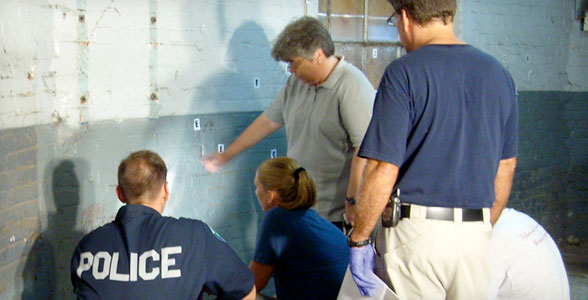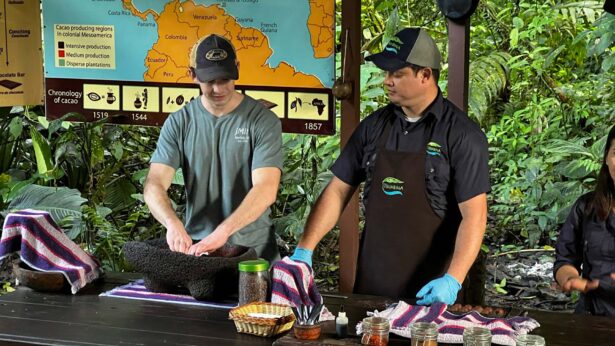By Brad Anderson
Every day the pop-culture wave of TV shows, like CSI and Law & Order, transport crime scene investigations out of shrouded police labs into the light of living rooms. The sky-high ratings and global syndication of shows related to forensic science are signs that many of us are playing armchair investigator, unraveling our favorite crime-show mysteries for pure entertainment.
While most of us can only suspend reality for an hour, one UT Allied Health Sciences medical technology graduate has been investigating real-life crime scenes for more than three decades – seeking the truth in blood trails. Paulette Sutton may not be recognized by the public like actors David Caruso and Gary Sinise, but she is known by medical examiners, attorneys, and crime scene investigators as one of the most respected and internationally renowned bloodstain pattern analysts in the world.
Sutton has fashioned one of the most unusual professions ever to emerge from the College of Allied Health Sciences. Time and again she has been called on to provide expert testimony on bloodstains, teach courses on methods of calculating angles and trajectory, analyze droplet types, and determine time frames based on blood clotting—far from ordinary work.
Sutton’s path from the small town of Obion, Tennessee, to gory crime scenes was not born out of a love for blood or forensics. After attending UT Martin, she entered the medical technology program at UTHSC. Her main objective when determining her area of concentration was simple – “I just wanted to travel,” says Sutton. She chose to pursue a career as an equipment technology specialist, repairing and installing highly specialized medical equipment across the continent.
Sutton’s post-graduation plan took a detour after a forensics lecture in one of her medical technology classes. The lecture, presented by Shelby County Medical Examiner’s Office chief serologist and UTHSC medical technology graduate Ann Fowler, intrigued Sutton. Just before graduating with a bachelor of science degree in 1976, she became aware of a position at the examiner’s office, which was a division of the UT Department of Forensic Pathology in Memphis. “The temptation was too great to pass up,” she recalls. “I thought I would just go and learn about forensics for a while and then continue on with my original plans.” That did not turn out to be the case.
In 1976, Sutton began what would become a 30-year career at the department as a forensic serologist – collecting, identifying, and analyzing semen, saliva, blood, and other bodily fluids from crime scenes to assist law enforcement officials in their investigations. Crime scenes were a far cry from equipment laboratories, and the only traveling was to local crime scenes. Nonetheless, Sutton quickly adapted and excelled in her new field of forensic science.
 Sutton’s medical technology education had honed the skills required to succeed in forensic science: precision and accuracy. Those abilities were deeply embedded in her work habits. This would benefit her during a time when the sophisticated testing of today did not exist. Her skills caught the eye of Dr. Jerry Francisco, retired UTHSC pathology professor, Shelby County’s first medical examiner, and a colleague Sutton credits as being a mentor.
Sutton’s medical technology education had honed the skills required to succeed in forensic science: precision and accuracy. Those abilities were deeply embedded in her work habits. This would benefit her during a time when the sophisticated testing of today did not exist. Her skills caught the eye of Dr. Jerry Francisco, retired UTHSC pathology professor, Shelby County’s first medical examiner, and a colleague Sutton credits as being a mentor.
“Paulette’s education in medical technology was a superb base for her career in forensic science,” Francisco says. “Besides being a very bright, innovative, and dedicated worker, she was very well trained.”
Francisco recognized that analyzing and interpreting bloodstains would be a great service for their department to offer Shelby County, with Sutton as the perfect fit. “I felt strong in supporting a focus or concentration to stand out from the ordinary. Paulette gravitated to it and had an invaluable ability to illustrate and communicate her ideas and techniques, which was a very important asset when presenting evidence to jurors,” Francisco says.
Although there was no formal education for bloodstain analysis, with Francisco’s support, Sutton attended bloodstain analysis courses at the North Louisiana Criminalistics Laboratory at the invitation of the director, Ray Herd. Sutton spent weeks at a time at the lab, a facility suitable for both living and training.
One of her course instructors in Louisiana was Herbert Leon MacDonell, author of Bloodstain Pattern Interpretation, recognized at the time as the standard reference book for bloodstain analysis. MacDonell agrees with Francisco’s assessment of Sutton. “Paulette was intelligent, asked great questions, and spoke very well,” he says.
Sutton became fascinated with what she learned from MacDonell and also credits him as a mentor. The two lecture together around the country to this day. “I wanted to accomplish and put into practice what Herb did in his book,” says Sutton, who was eager to put her training to use for Francisco and Shelby County.
Upon returning from her training in Louisiana, Sutton provided expert testimony in the hearing of a man accused of stabbing and killing his mother. It was the first time in Shelby County that bloodstain evidence was used in a conviction. The defendant claimed that his mother’s blood ended up on his shirt after he found and held her until the authorities arrived. Sutton interpreted the spatter types and locations on the defendant’s shirt to conclude that he committed the crime. Her determinations were so specific and scientifically sound that she also identified the hand he used in the stabbing. The defendant quickly changed his story and pled guilty.
Since then, Sutton has served as an expert witness and consultant for hundreds of state and federal cases as an authority in the fields of forensic serology, bloodstain pattern analysis, and crime scene reconstruction. Her expertise played an integral part in many high-profile trials, including the “Texas Dragging Death” and the Reverend Gerald Robinson case. She was also involved in the Phil Specter trial. To Sutton, the value of her work does not revolve around whether she works for the prosecution or defense – it is in finding the truth, which often goes beyond science.
When blood is shed in a crime, the stains can often scientifically tell the story when a case is void of a witness or confession. Sutton explained that each case presents a unique set of circumstances that requires critical thinking throughout the entire process. She describes her art as “one part math (measuring stains and calculating angles), one part physics (fluid behavior), and one part common sense (applying science to everyday life).”
 Sutton stops at nothing when devising means to interpret bloodstains. “Our determinations can be life or death,” she says. Her analysis often involves experimentation, such as mixing various environmental elements with blood.
Sutton stops at nothing when devising means to interpret bloodstains. “Our determinations can be life or death,” she says. Her analysis often involves experimentation, such as mixing various environmental elements with blood.
After collecting blood samples, she reconstructs every aspect of the scene to determine why the blood reacted a certain way. In one case her relentless pursuit of the truth led her to use her own blood to solve a case.
“There was a question of how long blood took to clot, so I recreated the environment using the same temperature and airflow as the scene. I then drew tubes of blood from my arm, placed it on my skin, and timed how long it took to clot.”
It doesn’t take long to realize that Sutton and her colleagues come from the opposite mind frame than the killers whose actions they reconstruct. “It hurts our feelings,” she says simply. “I have images in my head that people shouldn’t see. Some of them I will never talk about or show in a class.” Despite having to see the worst of humanity in her profession, Sutton says she and her colleagues focus on the science and making a difference.
When asked if there was a crowning moment in her career, one of which she is most proud, Sutton describes an event that “took the science out of it.”
“I testified in a case of a deputy killed in a squad car. Consequently, the defendant stopped the trial and pled guilty. The victim’s family approached and thanked me for finding out what happened. That made it real.
“It’s best for my fellow man that we get the right killers off the street,” she says. On the opposite end of the spectrum, she also makes a difference in the lives and families of those wrongfully accused. Sutton offers her services at no charge to the Innocence Project, a national litigation and public policy organization dedicated to exonerating wrongfully convicted people through DNA testing and to reforming the criminal justice system to prevent future injustice.
Sutton retired in 2006 after 30 years as practicing forensic scientist for the UT Department of Forensic Pathology. Even so, she is not far removed from her calling. She divides her time for hire between consulting and testifying in court cases, and providing numerous seminars and workshops on the science and math of bloodstains, crime scene documenting and processing, and how to provide testimony. Her classes conclude with students investigating and presenting theories to Sutton from her mock crime scenes. Some of Sutton’s clients include the Bloodstain Evidence Institute, the Federal Bureau of Investigation, the Italian Carabinieri, and the United States Marine Corps.
In 2005, she and her colleagues Stuart James and Paul Kish, authored Principles of Bloodstain Pattern Analysis, Theory and Practice published by CRC Press. It is the first bloodstain pattern book presenting dramatic, full-color images of bloodletting injuries, bloodstains, and crime scenes.
UT has always been a part of Sutton’s career and close to her heart…and her belongings.
Sutton proudly displays the orange “T” sports logo on just about anything she can fit one on, including the laptop she uses while lecturing. “This goes over big when I teach in Arkansas,” she says with a smile.
In addition to her role in the UT Department of Forensic Pathology, she was also an instructor at the UTHSC Colleges of Allied Health Sciences, Medicine, and Nursing and at the National Forensic Academy of the UT Institute for Public Service. Sutton never hesitates to present one of her educational and often humorous workshops to the medical technology students in the College of Allied Health Sciences Clinical Laboratory Sciences program. “I would not have gotten this far had it not been for the med tech program at UT.”



